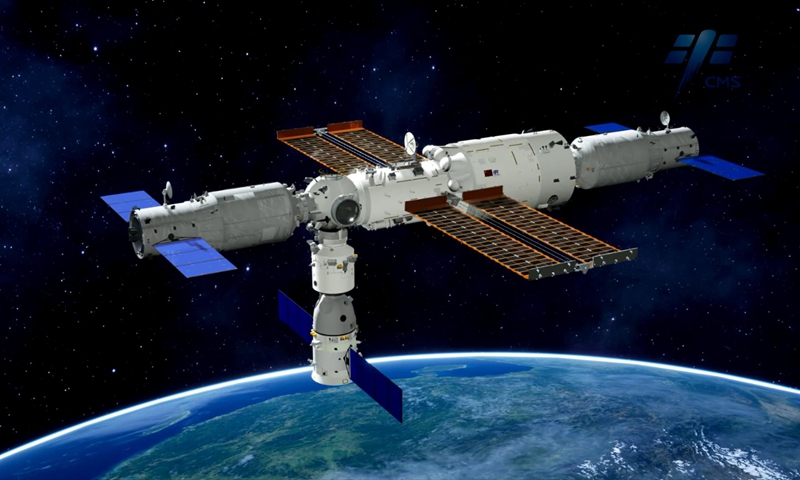
Photo:Web
Only six-and-a-half hours after the launch, the Shenzhou-13 manned spacecraft successfully docked with China’s Tianhe space station core cabin on Saturday early morning, after quick autonomous rendezvous, or as researchers call it, the ‘space waltz.’
The rendezvous and docking happened at 6:56 am on Saturday morning, six-and-a-half hours after traveling on a Long March-2F carrier rocket from the Jiuquan Satellite Launch Center in Northwest China's Gansu Province, the China Manned Space Agency (CMSA) said in a statement sent to the Global Times.
Docked at the bottom of the Tianhe core cabin from a radial direction, the spacecraft safely and smoothly delivered the second batch of residents to China’s space station.
A combination flight has been formed, consisting of the Tianhe core cabin at the center, and Shenzhou-13 manned craft, Tianzhou-2 and -3 cargo craft on the side, the CMSA said.
According to the spacecraft developers with the China Academy of Space Technology (CAST), they have designed a new rendezvous path and circling flight mode to support fast-docking in the radial direction.
As beautiful as the “space waltz” was, it was a lot more difficult than the front and rear docking with the Tianhe core cabin as the Shenzhou-12, Tianzhou-2 and -3 missions had exercised. “For front and rear dockings, there is a 200-meter holding point for the craft, enabling them to maintain a stable attitude in orbit even when engines are not working. However, radial rendezvous does not have such a midway stopping point, and it requires continuous attitude and orbit control,” the CAST said in a note to the Global Times.
It added that during the radial rendezvous, the spacecraft needs to turn from level flight to vertical flight with a wide range of attitude maneuvers, posing tough challenges for the "eyes" of the craft to see the target in time and ensure that the "eyes" will not be disturbed by complex lighting changes.
The success of this new docking method would be another sign of China's spacecraft docking capabilities, experts noted.
The Shenzhou-12 used the R-Bar docking technology shortly after its detachment from the core module in September, the Global Times previously reported.
The Shenzhou-13 mission crew, led by Zhai Zhigang and taikonauts Wang Yaping and Ye Guangfu, will stay in space for six months, double the time of the Shenzhou-12 crew.
They are expected to return to earth next spring, which means they will celebrate a special, unforgettable Chinese Lunar New Year in space.
They are tasked to carry out two to three extravehicular activities, better known as spacewalks. Wang Yaping will participate in at least one spacewalk, becoming the first Chinese woman to achieve such a feat, the Global Times learned from mission insiders.
According to the CMSA, they are also expected to install transfer gears linking the big and small robotic arms and related suspension gears for future construction work.

